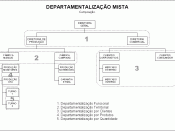The definition of an Organization can be defined as "A structure through which individuals cooperate systematically to conduct business". It includes routine behaviors, norms, or a type of climate that is conveyed. The purpose and function of culture in the workplace is to help create and maintain integration, bring employees from all levels of the organization closer together, and to enhance performance and productivity.
Understanding Culture
Basically, organizational culture is the personality of the organization. Culture is made up of the assumptions, values and norms of organization members and their behaviors. Members of an organization soon realize the particular culture of an organization shortly after being hired. Culture is one of those terms that are difficult to express distinctly, but everyone knows it when they see it. For example, the culture of a large, for-profit corporation is quite different than that of a hospital which is quite different that that of a university.
You can tell the culture of an organization by looking at the arrangement of furniture, what they brag about, what members wear, etc., similar to what you can use to get a feeling about someone's personality.
The culture of an organization operates at both a conscious and unconscious level. Often the people who see an organizations culture more clearly are those from the outside, the new hires, the consultants or vendors. Those not living inside the culture can often see it more objectively. Better to ask a New Yorker to tell you what Californians are like than ask a Californian.
Cultural Change and its Importance
The concept of culture is very important when attempting to manage an organization-wide change. Organizations are realizing that, despite the best-laid out plans, organizational change must include not only changing structures and processes, but also changing the corporate culture as well.
There has been a great deal of literature written over the years about the concept of organizational culture, particularly in regards to learning how to change organizational culture. Mass organizational change efforts have failed the majority of the time. Usually, this failure is due to the lack of understanding that culture plays a strong role in an organization and its functions. That's one of the reasons that many strategic planners for organizations now place more emphasis on culture as they do mission and vision.
Types of Culture
There are different types of culture just like there are different types of personality. Researcher Jeffrey Sonnenfeld (1990) has identified the following four types of cultures in his perception:
1. Academy Culture
Employees are highly skilled and tend to stay in the organization, while working their way up the ranks. The organization provides a stable environment in which employees can development and exercises their skills. Examples are universities, hospitals, large corporations, etc.
2. Baseball Team Culture
Employees are "free agents" who have highly prized skills. They are in high demand and can rather easily get jobs elsewhere. This type of culture exists in fast-paced, high-risk organizations, such as investment banking, advertising, etc.
3. Club Culture
The most important requirement for employees in this culture is to fit into the group. Usually employees start at the bottom and stay with the organization. The organization promotes from within and highly values seniority. Examples are the military, some law firms, etc.
4. Fortress Culture
Employees don't know if they'll be laid off or not. These organizations often undergo massive reorganization. There are many opportunities for those with timely, specialized skills. Examples are savings and loans, large car companies, etc.
Possible Cultural Conflicts
There seems to be a wide misconception that throughout an organization or within a specific department within an organization, there is only one uniform culture that exists. This perception does not seem right because it fails to recognize that in many organizations there are groups that are unique within the dominant culture. They may have values that are not consistent with norm of their culture or they may outwardly reject the culture as a whole, yet they are still able to maintain their social position within the culture.
Strong organizational culture can in fact be negative, and actually damage the performance of other employees that are not within that culture group. This concept is due to the fact that in many organizations the predominant culture can act as a barrier to an employee that wishes to gain status within the organization.
Overall, culture in an organization is a very touchy and in detailed subject. What is evident is that Culture drives the organization and its actions. It is somewhat like "the operating system" of the organization.
References
Frow, Stephen M., BS, MS, PhD; Kartman, Sandra, BA, MBA, PhD, "Organizational Culture: Its Impact on Employee Relations", Health Care Manager, 2002 (2), 22-28. Retrieved November 1, 2003 from http://www.hcnet.com/htm/articles/understanding-Culture.html
Zumal, Janet L., Ph.D, "Organizational Culture Inventory Development", Human Synergistic/Center for Applied Research, Source Publishing, 1998. Retrieved October 31, 2003 from http://www.srg.co.uk/culture.html



Cite Sources.
Good content but the information is word for word out Internet source. Should be cited if using others work.
http://www.managementhelp.org/org_thry/cul ture/culture.htm#anchor1428305
0 out of 0 people found this comment useful.